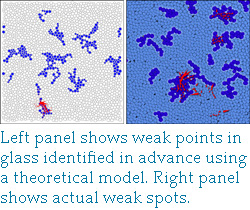NSF I-Corps Semiconductor and Microelectronics Free Virtual Course Being Offered
University researchers with groundbreaking ideas in semiconductors, microelectronics or advanced materials are invited to apply for an entrepreneurship-focused hybrid course offered through the National Science Foundation (NSF) Innovation Corps (I-Corps) program. The free virtual course runs from Sept. 15 through…


 A collaboration of researchers has combined a theoretical model with a first-of-its kind experiment to demonstrate a novel method for identifying “soft spots” in such materials. The findings of physicists from Syracuse University and the University of Pennsylvania, which are published online in separate studies in Physical Review Letters, may lead to a better understanding of the principles that govern the responses of materials under stress, ranging from failure of glass to earthquakes and avalanches.
A collaboration of researchers has combined a theoretical model with a first-of-its kind experiment to demonstrate a novel method for identifying “soft spots” in such materials. The findings of physicists from Syracuse University and the University of Pennsylvania, which are published online in separate studies in Physical Review Letters, may lead to a better understanding of the principles that govern the responses of materials under stress, ranging from failure of glass to earthquakes and avalanches.